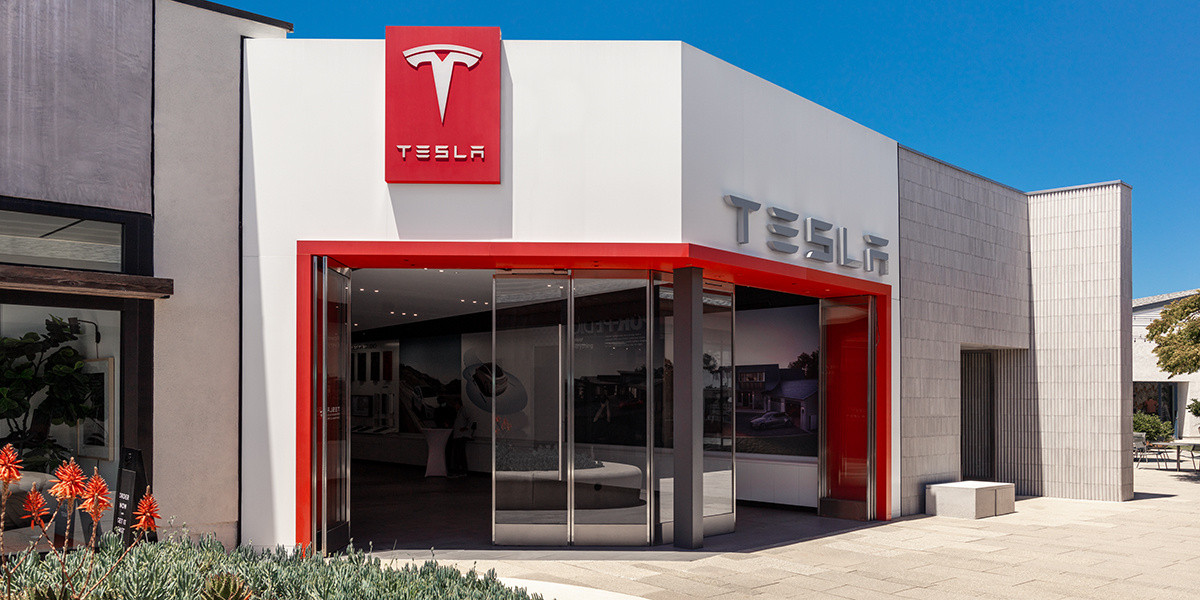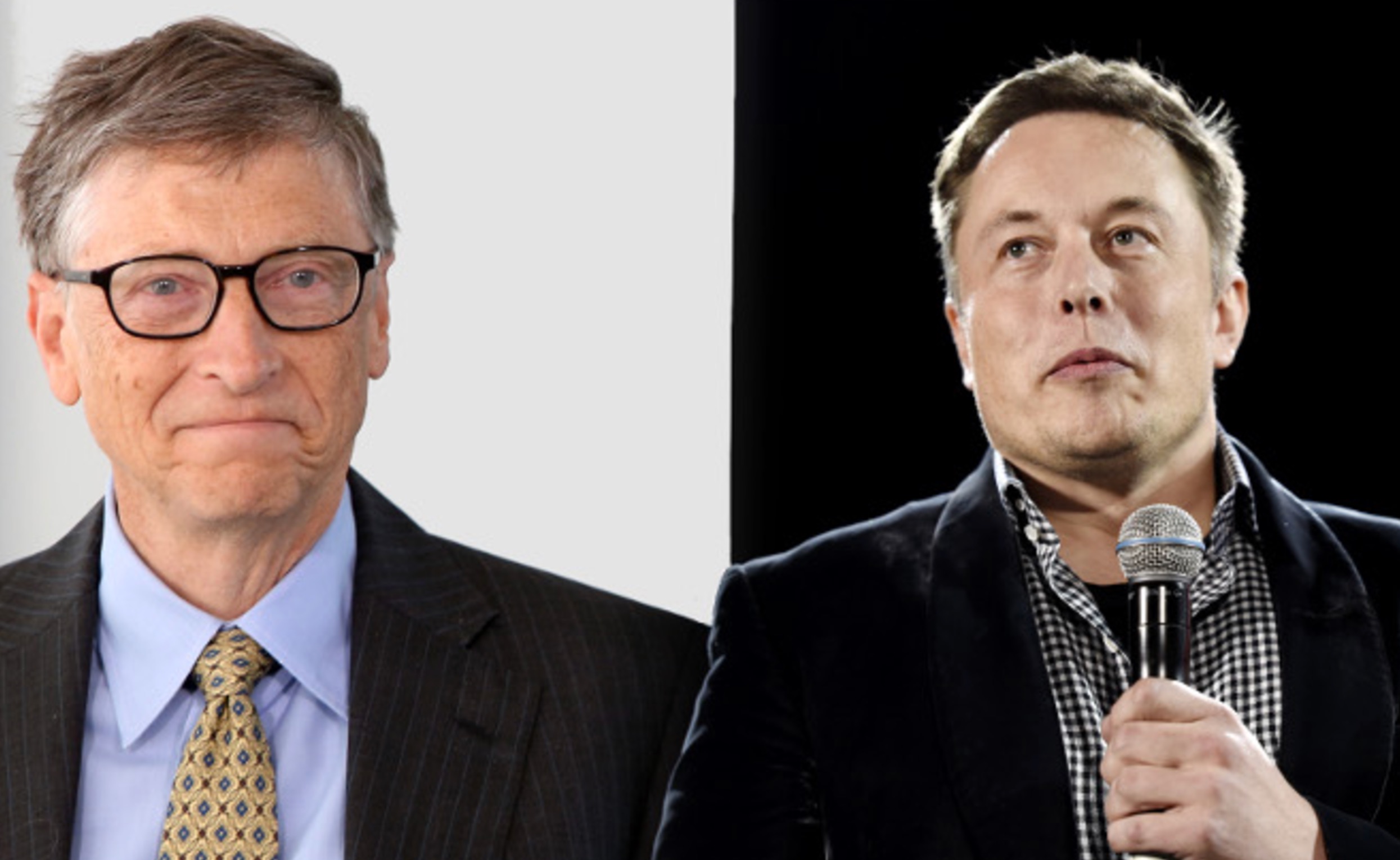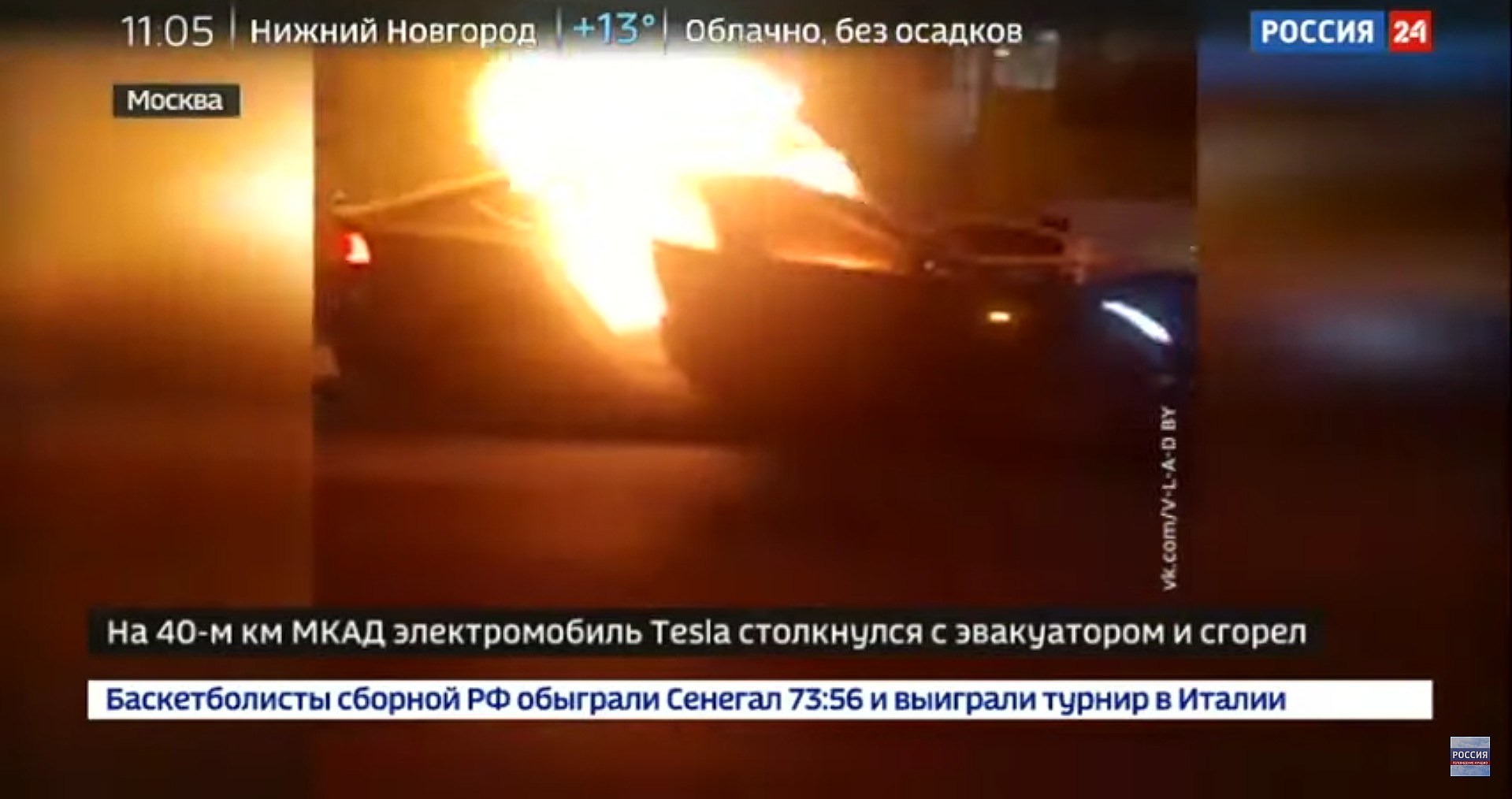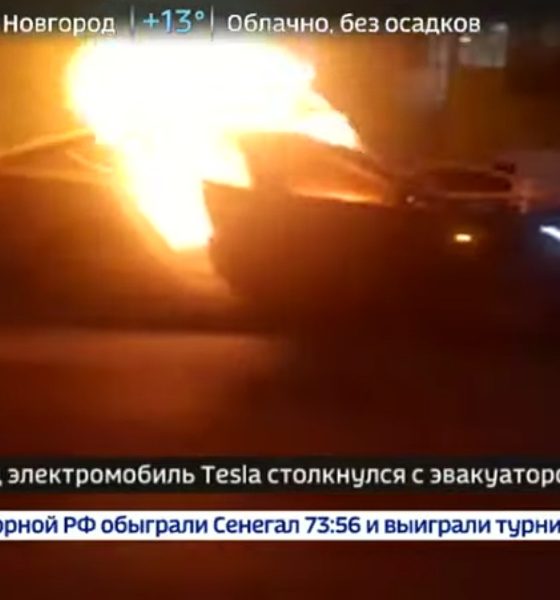This past Saturday, news broke about a Tesla crashing into a parked tow truck and bursting into flames on a motorway in Moscow, Russia. Particularly notable about the incident was that after the initial crash, explosions racked the already burning electric car.
A number of developments have emerged about the story so far, which clarified initial misconceptions about the incident, from the make of the vehicle to the injuries incurred by its occupants. With this in mind, Teslarati has compiled this quick guide about what is currently known about this crash and its ensuing fiery aftermath.
The crash
A video of the accident taken from what appears to be a security camera showed the electric sedan passing a first stopped vehicle that had broken down and catching the corner of a tow truck that was sticking out into the adjacent lane. In a statement to CrimeRussia, Aleksey Tretyakov, the vehicle’s owner, noted that he had been traveling at 100 km/h, the speed limit in the area. The impact from the collision was enough to push the tow truck forward into the central dividing wall.
A video of the exact moment the Tesla crashed into the tow truck could be viewed below.
The make of the car
Initial reports that emerged following the accident tagged the Tesla as a Model S. With more videos of the crash’s aftermath emerging online, it now appears that the electric car involved in the accident was a Model 3, at least based on the shape of the vehicle’s taillights and headlights.
The fire
Videos of the Tesla on fire and the explosions that followed emerged on the heels of the accident. These clips, which were separate from the footage of the electric car crashing into the parked tow truck, showed a vehicle that was already ablaze. Two explosions could be seen in the videos, which resulted in parts of the electric car flying to the air.
Quite interestingly, the explosion within the vehicle seemed to have happened after the tow truck that the Tesla crashed into had been moved (the heavy vehicle does not seem to be in the vicinity when the explosions happened). As observed by Tesla Motors Club member KarenRei, the nature of the explosion in the Model 3 looked notably similar to an explosion that happens when an airbag explodes. A video of such an incident could be viewed here.
The injuries
Initial reports of the injuries that resulted from the accident pointed to the driver of the Tesla and his two children being severely injured. Russian media outlet IXBT.com, for one, noted that Tretyakov was in “intensive care” due to the crash. Later reports would prove this to be false. Speaking with CrimeRussia, the Tesla owner noted that both of his legs were broken due to the accident, but his two children were “practically not injured.”
Update: While CrimeRussia noted in its coverage of the incident that the Model 3 driver had two broken legs as a result of the crash, it appears that the news agency misquoted the Tesla owner’s statements. Vladimir Grinshpun, a native Russian speaker, noted in a message to Teslarati that the Tesla owner clearly stated during a video interview with the news agency that he had one broken leg and a broken nose due to the accident. A video of this interview could be accessed here.
A video depicting what appeared to be Tretyakov hobbling away from his vehicle as his two children walked ahead of him has also been aired on Russian media outlet Russia 24.
On Autopilot
Being a Tesla crash, it was not surprising to note that several reports promptly related the crash to the potential use of Autopilot. Discussing the incident, longtime TMC member mongo noted that since Teslas in Russia are imported through a third party, there was likely no Navigate on Autopilot support in the area. Thus, functions of Autopilot would likely be limited to basic features such as lane-keeping.
This was mentioned by Tretyakov himself, who noted that he was using a “driver-assist” feature and a “trimmed” version of Autopilot when the accident happened. The Tesla owner added that he was holding the wheel in the moments leading up to the crash, though he also admitted that he did not notice the parked tow truck on the road. Based on the video of the Tesla’s crash, it appears that either the vehicle or Tretyakov engaged the brakes just before the car hit the parked truck.
Tesla’s statement
Tesla is yet to issue a formal statement about the incident, though the electric car maker has recently published its most recent vehicle accident and fire data. Tesla notes that from 2012 – 2018, “there has been approximately one Tesla vehicle fire for every 170 million miles traveled. By comparison, data from the National Fire Protection Association (NFPA) and U.S. Department of Transportation shows that in the United States there is a vehicle fire for every 19 million miles traveled.” It should be noted that Tesla’s data set includes instances of vehicle fires caused by structure fires, arson, and other things unrelated to the vehicle, which account for about 15% of Tesla vehicle fires over this time period.
H/T JPR007 on Twitter.

News
Tesla dispels reports of ‘sales suspension’ in California
“This was a “consumer protection” order about the use of the term “Autopilot” in a case where not one single customer came forward to say there’s a problem.
Sales in California will continue uninterrupted.”

Tesla has dispelled reports that it is facing a thirty-day sales suspension in California after the state’s Department of Motor Vehicles (DMV) issued a penalty to the company after a judge ruled it “misled consumers about its driver-assistance technology.”
On Tuesday, Bloomberg reported that the California DMV was planning to adopt the penalty but decided to put it on ice for ninety days, giving Tesla an opportunity to “come into compliance.”
Tesla enters interesting situation with Full Self-Driving in California
Tesla responded to the report on Tuesday evening, after it came out, stating that this was a “consumer protection” order that was brought up over its use of the term “Autopilot.”
The company said “not one single customer came forward to say there’s a problem,” yet a judge and the DMV determined it was, so they want to apply the penalty if Tesla doesn’t oblige.
However, Tesla said that its sales operations in California “will continue uninterrupted.”
It confirmed this in an X post on Tuesday night:
This was a “consumer protection” order about the use of the term “Autopilot” in a case where not one single customer came forward to say there’s a problem.
Sales in California will continue uninterrupted.
— Tesla North America (@tesla_na) December 17, 2025
The report and the decision by the DMV and Judge involved sparked outrage from the Tesla community, who stated that it should do its best to get out of California.
One X post said California “didn’t deserve” what Tesla had done for it in terms of employment, engineering, and innovation.
Tesla has used Autopilot and Full Self-Driving for years, but it did add the term “(Supervised)” to the end of the FSD suite earlier this year, potentially aiming to protect itself from instances like this one.
This is the first primary dispute over the terminology of Full Self-Driving, but it has undergone some scrutiny at the federal level, as some government officials have claimed the suite has “deceptive” naming. Previous Transportation Secretary Pete Buttigieg was vocally critical of the use of the name “Full Self-Driving,” as well as “Autopilot.”
News
New EV tax credit rule could impact many EV buyers
We confirmed with a Tesla Sales Advisor that any current orders that have the $7,500 tax credit applied to them must be completed by December 31, meaning delivery must take place by that date. However, it is unclear at this point whether someone could still claim the credit when filing their tax returns for 2025 as long as the order reflects an order date before September 30.

Tesla owners could be impacted by a new EV tax credit rule, which seems to be a new hoop to jump through for those who benefited from the “extension,” which allowed orderers to take delivery after the loss of the $7,500 discount.
After the Trump Administration initiated the phase-out of the $7,500 EV tax credit, many were happy to see the rules had been changed slightly, as deliveries could occur after the September 30 cutoff as long as orders were placed before the end of that month.
However, there appears to be a new threshold that EV buyers will have to go through, and it will impact their ability to get the credit, at least at the Point of Sale, for now.
Delivery must be completed by the end of the year, and buyers must take possession of the car by December 31, 2025, or they will lose the tax credit. The U.S. government will be closing the tax credit portal, which allows people to claim the credit at the Point of Sale.
🚨UPDATE: $7,500 Tax Credit Portal “Closes By End of Year”.
This is bad news for pending Tesla buyers (MYP) looking to lock in the $7,500 Tax Credit.
“it looks like the portal closes by end of the year so there be no way for us to guarantee the funds however, we will try our… pic.twitter.com/LnWiaXL30k
— DennisCW | wen my L (@DennisCW_) December 15, 2025
We confirmed with a Tesla Sales Advisor that any current orders that have the $7,500 tax credit applied to them must be completed by December 31, meaning delivery must take place by that date.
However, it is unclear at this point whether someone could still claim the credit when filing their tax returns for 2025 as long as the order reflects an order date before September 30.
If not, the order can still go through, but the buyer will not be able to claim the tax credit, meaning they will pay full price for the vehicle.
This puts some buyers in a strange limbo, especially if they placed an order for the Model Y Performance. Some deliveries have already taken place, and some are scheduled before the end of the month, but many others are not expecting deliveries until January.
Elon Musk
Elon Musk takes latest barb at Bill Gates over Tesla short position
Bill Gates placed a massive short bet against Tesla of ~1% of our total shares, which might have cost him over $10B by now

Elon Musk took his latest barb at former Microsoft CEO Bill Gates over his short position against the company, which the two have had some tensions over for a number of years.
Gates admitted to Musk several years ago through a text message that he still held a short position against his sustainable car and energy company. Ironically, Gates had contacted Musk to explore philanthropic opportunities.
Elon Musk explains Bill Gates beef: He ‘placed a massive bet on Tesla dying’
Musk said he could not take the request seriously, especially as Gates was hoping to make money on the downfall of the one company taking EVs seriously.
The Tesla frontman has continued to take shots at Gates over the years from time to time, but the latest comment came as Musk’s net worth swelled to over $600 billion. He became the first person ever to reach that threshold earlier this week, when Tesla shares increased due to Robotaxi testing without any occupants.
Musk refreshed everyone’s memory with the recent post, stating that if Gates still has his short position against Tesla, he would have lost over $10 billion by now:
Bill Gates placed a massive short bet against Tesla of ~1% of our total shares, which might have cost him over $10B by now
— Elon Musk (@elonmusk) December 17, 2025
Just a month ago, in mid-November, Musk issued his final warning to Gates over the short position, speculating whether the former Microsoft frontman had still held the bet against Tesla.
“If Gates hasn’t fully closed out the crazy short position he has held against Tesla for ~8 years, he had better do so soon,” Musk said. This came in response to The Gates Foundation dumping 65 percent of its Microsoft position.
Tesla CEO Elon Musk sends final warning to Bill Gates over short position
Musk’s involvement in the U.S. government also drew criticism from Gates, as he said that the reductions proposed by DOGE against U.S.A.I.D. were “stunning” and could cause “millions of additional deaths of kids.”
“Gates is a huge liar,” Musk responded.
It is not known whether Gates still holds his Tesla short position.










